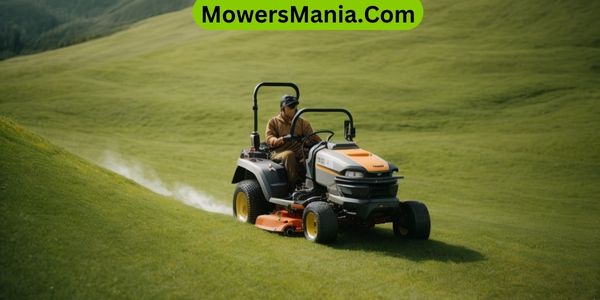If you’re tackling a slope with your mower, it’s important to do it safely.
In this article, we’ll cover everything you need to know about mowing on a slope. From choosing the right mower to mowing techniques and safety precautions, we’ve got you covered.

So grab your gear and let’s make sure you’re equipped to handle those inclines without any mishaps.
Choosing the Right Mower
When mowing on a slope, you should select a mower with a low center of gravity for stability and control. This is crucial for preventing the mower from tipping over and causing accidents.
Look for mowers specifically designed for slopes, as they often have features like wider wheelbases, which help improve stability.
Additionally, consider mowers with adjustable cutting heights, as these will allow you to adapt to the varying terrain of the slope.
It’s also important to choose a mower with good traction to prevent slipping on the incline. Some mowers come with special tires or treads designed to provide better grip on sloped surfaces.
Furthermore, opt for mowers with powerful engines, as these will help propel the mower up the slope with ease. When dealing with steeper slopes, a self-propelled mower can be particularly beneficial, as it reduces the physical effort required to maneuver the machine.
Lastly, always ensure that the mower you choose is in good working condition, with sharp blades and properly inflated tires, to optimize its performance and safety on slopes.
Preparing the Slope
How do you assess the slope’s terrain and remove any obstacles before mowing?
Before you start mowing on a slope, it’s crucial to prepare the terrain to ensure a safe and effective mowing experience.
Here’s how to prepare the slope:
- Assess the Terrain: Walk the slope and assess the terrain to identify any uneven areas, holes, or other potential hazards. Look for any areas where the ground is particularly soft or steep, as these may pose challenges when mowing.
- Remove Obstacles: Clear the slope of any rocks, branches, or other debris that could interfere with the mower or pose a safety risk. It’s important to ensure that the path is clear to prevent any potential accidents or damage to the mower.
- Consider Soil Moisture: Check the moisture level of the soil on the slope. Mowing on excessively wet soil can be hazardous, leading to slipping or loss of control. If the soil is too wet, consider postponing mowing until it dries out to reduce the risk of accidents.
Mowing Techniques for Slopes

To safely mow on a slope, carefully maneuvering the mower and maintaining a steady pace is essential for preventing accidents and achieving a well-groomed lawn. When mowing on a slope, it’s crucial to use a push mower rather than a riding mower for better control and stability.
Start by mowing across the slope instead of up and down to minimize the risk of the mower tipping over. Always keep a firm grip on the handlebars and be prepared to adjust your body position as needed to counterbalance the slope’s angle. If the slope is excessively steep, consider using a string trimmer or a specialized slope mower instead.
Another effective technique is mowing in a zigzag pattern, gradually working your way up or down the slope. This method helps distribute the weight of the mower more evenly and reduces the risk of it sliding or tipping. Remember to take it slow and avoid sudden turns or changes in direction to maintain control.
Safety Precautions
To ensure safe mowing on a slope, maintain a firm grip on the handlebars and keep a watchful eye on your footing. Safety precautions are crucial when mowing on a slope to prevent accidents and injuries.
Here are three essential safety measures to follow:
- Wear appropriate footwear: Choose sturdy, non-slip footwear to provide better traction and stability while mowing on a slope. Avoid wearing open-toed shoes or sandals as they can increase the risk of slipping and losing your footing.
- Be mindful of obstacles: Before mowing, clear the area of any rocks, tree roots, or debris that could cause the mower to lose traction or create tripping hazards. Keep an eye out for any unexpected changes in the terrain as you mow.
- Use a slow and steady pace: Avoid sudden movements or sharp turns while mowing on a slope. Maintain a consistent and steady pace to ensure better control of the mower and reduce the risk of losing balance.
Aftercare and Maintenance

After mowing on a slope, it’s important to carefully inspect the mower for any signs of damage or wear, and promptly address any issues to ensure continued safe operation.
Start by checking the blades for any dents, bends, or dullness. Dull blades can tear grass instead of cleanly cutting it, leading to an unhealthy lawn.
Next, examine the wheels and axles for any signs of bending or damage, as these parts are crucial for maintaining stability on slopes.
Inspect the mower deck for cracks, dents, or any other damage that could affect its structural integrity.
Additionally, check the oil and fuel levels, and top them up as needed. Proper lubrication and fuel are essential for the mower’s engine to function optimally.
Lastly, clean the mower to remove grass clippings and debris, paying special attention to the undercarriage and the air intakes to prevent overheating and ensure proper airflow.
Regular maintenance, such as sharpening blades and tightening loose parts, is also crucial for safe and efficient mowing on slopes.
Frequently Asked Questions [FAQs]
Can I Use a Regular Mower on a Slope, or Do I Need a Specific Type of Mower?
You can use a regular mower on a slope, but it’s safer to use a mower specifically designed for slopes. These mowers have features like low center of gravity and traction control to prevent accidents.
How Often Should I Mow My Slope to Maintain Its Health and Appearance?
You should mow your slope regularly to maintain its health and appearance. Mowing frequency depends on the type of grass, climate, and season. Generally, aim to mow every 1-2 weeks, adjusting as needed for optimal results.
Are There Any Specific Environmental Considerations I Should Keep in Mind When Mowing a Slope?
When mowing a slope, consider environmental factors like soil erosion, water runoff, and potential chemical runoff into nearby water sources. These can impact the health of the slope and surrounding environment. Be mindful.
What Are Some Signs That My Slope May Be Too Steep to Mow Safely?
If you notice your mower struggling to climb the slope, or if you feel unsteady or unsafe while mowing, these are signs that your slope may be too steep to mow safely.
Are There Any Alternative Methods to Mowing That I Should Consider for Maintaining a Slope?
You should consider alternative methods for maintaining a slope, like using a string trimmer or a brush cutter. These tools can help you effectively manage the vegetation on a slope without the risks associated with mowing.
Conclusion
Now that you know how to safely mow on a slope, you can enjoy keeping your lawn tidy without risking injury.
Remember to:
- Choose the right mower for the job
- Prepare the slope properly
- Use the correct mowing techniques
- Take safety precautions
- Perform aftercare and maintenance
By following these steps, you can ensure a beautiful lawn while staying safe.
Happy mowing!



